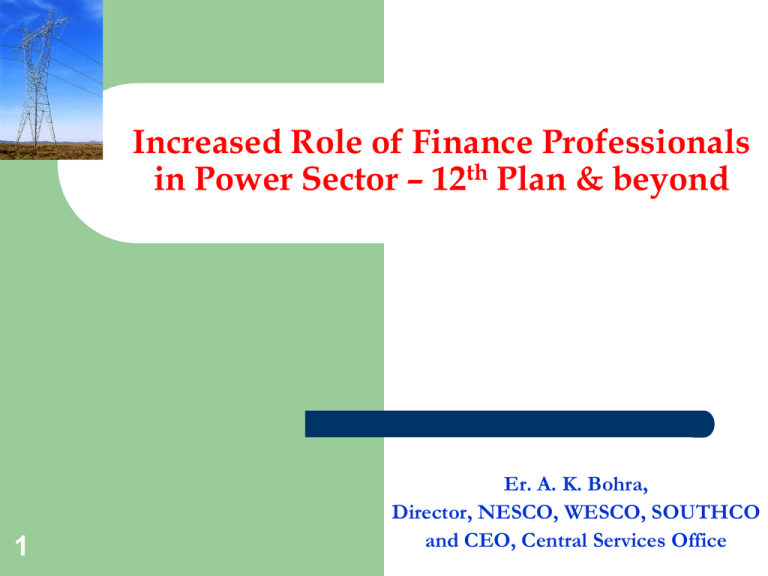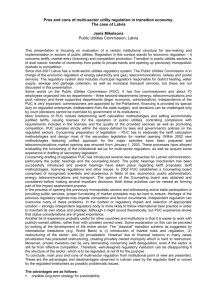File
advertisement

Increased Role of Finance Professionals in Power Sector – 12th Plan & beyond 1 Er. A. K. Bohra, Director, NESCO, WESCO, SOUTHCO and CEO, Central Services Office Context 2 India had set its eyes ten years back on the all round development of infrastructure and basic amenities The Power Sector has been considered for major investments beginning from Generation (setting up UMPPs), Transmission (intra-State lines & express corridors between North to South) and Distribution (Rural Electrification, Strengthening Infrastructure Backbone & Automation - RAPDRP) The present Government has rolled the activities on fast track to attain the mandate of Inclusive Development The Union Government estimates investment of $1 trillion towards infrastructure development in the 12th plan period Potential Ahead; Power Sector At one end “Make in India” like campaign programmed and on the other hand various legislatures are in offing to create favorable atmosphere for investment 12th Plan period- Power Sector Generation capacity addition targets 88,537 MW, comprising 26,182 MW in the central sector, 15,530 MW in the state sector, and 46,825 MW in the private sector respectively In order to meet this capacity addition in 12th Plan, an addition of 90,000 ckm of 765-220 kV lines, 154,000 MVA of Substation capacity and 27,350 MW of national grid capacity is required which would attract an investment of USD 35 billion 3 Potential Ahead; Power Sector 4 In the Distribution Sector, focus is laid not only on the addition of the lines & Sub-stations and energization of villages & households but separate investment is planned for strengthening and reinforcement the existing network As per erstwhile planning commission’s estimation, the Distribution sector requires an investment of Rs. 3.06 lakh Cr. towards building 6.95 lakh Kms of primary network & 6.1 lakh Kms of LV system Whereas the 12th Plan RGGVY scheme, now subsumed with DDUGJY (Deen Dayal Upadhyay Gram Jyoti Yojana), focuses on the extension of Distribution network to achieve the goal of “Power for All”, the newly launched DDUGJY & IPDS schemes targets on the strengthening of existing infrastructure and modernization Potential Ahead; Power Sector 5 The plan outlay of DDUGJY is Rs. 43K Crore and in IPDS Rs. 33.6K Cr. R-APDRP balance funds is Rs.16K Cr. and RGGVY Phase-II funding is Rs.39K Cr. Besides above States are also extending Budgetary support for Power Sector infrastructure development Odisha so far has achieved electrification target of 75% and have old & fragile backbone distribution network and expects around 5% share from the above Schemes The proper resource planning and timely execution of works to accomplish the above referred investment targets require synergy of financial & technical skills Insight of Regulated Distribution 6 After the Reforms undertaken a decade back, the Power Distribution has been a Regulated Entity The Power purchase is regulated & consequential revenue and expenses are also regulated On an average a Distribution Utility in a State has a Turnover of Rs. 500 – 1000 Cr. out of which the Power purchase cost covers nearly 75%, Employee cost 10 – 12% and balance is R&M, A&G, Depreciation, Interests, RoE etc. The improper Tariff setting by the Regulators and leaving the Revenue gap or creation of Regulatory Assets has caused majority of the Utilities in financial distress in spite of receipt of subvention from respective State Govt. Insight of Regulated Distribution 7 To bail out Distribution Utilities specifically in Govt. possession or controlled, Central Govt. launched Financial Restructuring Plan (FRP) and National Electricity Fund (NEF) two years back but still it has not been of great help to many Utilities for varied reasons It is a fact that, in spite of all these efforts, the nationwide average AT&C loss is still remaining as high as 25%, Odisha has 37% It is essential that, every Utility is sustainable at its own This can only be possible through adopting prudent financial policies, resource management and high degree of skill sets along with efficient performance Increased Role of Finance Professionals 8 The recent Electricity Act Amendment Bill placed in the Parliament, proposes segregation of the wired (Carriage) & supply (Content) Business which necessitates segregation of Assets & Liabilities between the two Entities The exercise becomes more complex when multiple Supply agencies are licensed in a single area of operation This would require a perfect Asset valuation and identification of receivables from consumers In segregated Entities the Distribution Assets would remain with Distribution/Wires Utility and Receivables likely to be parked with the Supply Licensee along with the past dues of Power purchase Increased Role of Finance Professionals 9 As the many Entities would be involved in the Power sale, purchase, wheel & supply of power to millions of consumers, lot of reconciliations on regular basis would be required along with intensive Auditing As competition will be generated in the Supply business through a flexible Tariff, the cost control would also attain paramount importance This casts more responsibility on the Finance professionals The involvement of online Accounting, implementation of ERP, Inventory management & Financial planning through IT intervention would now be most essential Increased Role of Finance Professionals 10 To get geared up, immediate action required for up-gradation of the existing finance and accounting System, so that before the proposed amendment in Act is promulgated, the Utilities are equipped to implement it properly Recently amended Companies Act also mandates for intensive Auditing even in the Private controlled Utilities This creates abundance of opportunities for the Finance professional to prove their skill set and help Power Distribution Sector (Wire as well as Supply) turning to a Viable Proposition Thank You 11











